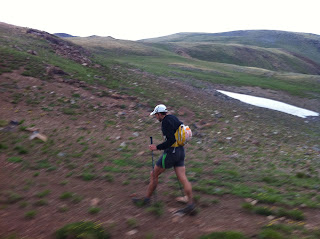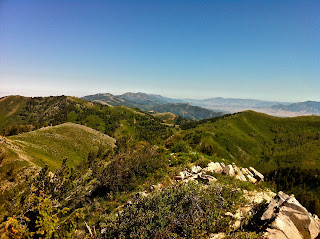It seemed like a reasonable hypothesis: the generous cash purse, the pre-race hype, and the astonishingly deep level of international competition in the men's field all combined to ensure a blistering, testosterone-fueled pace from the start on an unrelenting course with hot temps at altitude. The perfect recipe for a late-race charge into the top-10, or so I thought. (1)
As I crested Hidden Peak the first time in around 1:34 and change (2), stopped to fill up my bottle, began the descent into Mineral Basin and almost immediately started feeling awful it slowly dawned on me that there was a good chance that I was soon to be that very carnage. Indeed, this hunch appeared to be confirmed over the next 2.5 hours down Mary Ellen Gulch to Pacific Mine and back up over Baldy which were uniformly marked by woozy nausea, suffering, self-pity, and bilateral leg cramps that intensified any time I tried to force my pace past a stumbling trot. Strangely, I must not have been alone in this stark decompensation as I don't think my position overall in the race (about 15th place) changed much at all during this difficult middle section. Nonetheless, this private suffering was broken and at least momentarily alleviated by the surrounding beauty (the wildflowers were about as intense as I've ever seen them) as well as seeing friends out on the course: Geof and Paige, Rob, Jared, Matt with his GoPro, Pete- all of whom offered inspiration and rejuvenation.
Karl Meltzer's sadistic brain child, the Speedgoat 50k boasts almost 12,000 feet of vertical climbing on a mix of dirt service roads, singletrack, old mining trail, stream beds, and off-trail grass and talus slopes around the beautiful peaks of Snowbird ski resort. Given the race's inclusion in the Skyrunning Series and the financial incentives offered to the top 3 racers, this year's race included a long-list of mountain and ultrarunning luminaries whose collective arrival in the Wasatch raised the mean VO2 max of the Salt Lake valley by a standard deviation. As I stood on the start line at 6:30 am I reached over Kilian Jornet's head to high-five Bethany and wish her good luck. That would be the last time I saw this diminutive mountain running god until I padded through the finish line almost a full hour after he had.
Time distorts recall and - as is the case with every race- a year from now the burned memory traces of pain will have softened and mellowed into a nostalgic, halcyon haze. But as I made my troubled way along the course I marveled in astonishment at how much more this seemed to hurt than the year prior- a race in which I had also climbed the first peak fairly hard and then proceeded to go off-course for approx. 20 minutes with Joe Grant, Nick Clark, and Scott Jaime, rejoining the race having lost a discouraging 10 places or so (see 2011 race report here).
Runners often describe their off days and off races with an air of mystery and incomprehensibility: the legs just didn't have it, the running gods were simply not in my favor, etc. While there may occasionally be a kernel of truth to this vague, pseudo-mystical mumbo-jumbo (indeed the vastly complex workings of the body and mind often outstrip our epistemological capacities) I think far more often there are several ready-at-hand reasonable explanations. The fact is, most of us don't race all that often (relatively speaking) and are not capable of pushing anywhere near as hard in training as we are on race day: when things don't go as well as expected in a race situation there are generally good reasons, even in the absence of illness, injury, and lightning strikes.
In my case it was probably just a matter of simple fitness. Having been sidelined with a stress fracture in my foot I've only had about 8 weeks of running and these have been made up entirely of slow-paced easy runs. I've had decent volume and vertical (about 100,000 feet of climbing over the last month) but nothing in the way of high-intensity training. In contrast, during the race my heart rate didn't dip below 170 until well over 2 hours into the race. It's no surprise then that I needed about 2 hours to recuperate out on the course before I started to come around and actually feel like I could compete again, which I finally did for the last 1.5 hours of the race. For most of the rocky descent to Pacific Mine I tried to mentally psych myself up by just thinking about Bethany who was poised to give Anna Frost a legitimate run for her money for 1st place female. This was short-lived however as upon returning on the out-and-back portion I ran into her coming in, about 5-8 minutes behind Anna, her normally long and graceful stride now choppy and antalgic due to badly blistered feet. She did not look like a happy camper but still managed to encourage me. (She ended up dropping, bummer.)
As I traversed off Baldy and then dropped down again at around mile 23/24 I started feeling renewed. It seemed like I could fill my lungs again, the cramping subsided, and my legs actually felt like running finally. I passed Jorge Maravilla just prior to the final climb, ascended strongly, and then caught and passed Ryan Smith just before topping out on Hidden Peak 2. Ryan and I ran a good portion of the descent together, prematurely congratulating each other on an imminent finish before he sped up and put 2 minutes on me in the last several miles. While I had experienced no pain from my stress fracture site the whole race I noticed a familiar and concerning pang over the last few miles and (of course looking behind my shoulder first) backed off. The foot continued to hurt for the next day or so but I ran Lookout Peak today relatively quick with no pain so I think I'm thankfully in the clear.
While this year's race had a different flavor given the intensity of competition and the density of spectators out on the course Karl still managed to create the same laid-back and friendly atmosphere. Despite some difficult decision-making regarding prize money the event went off flawlessly- my only regret is not being able to simultaneously spectate and witness firsthand the spectacular performances of the top dogs. A big thanks to Zoe for watching our halfling while we both ran.
(1) This positive-split strategy will likely pay huge dividends for David Rudisha in the 800m Olympic Final and may be advisable in championship cross-country 8k races where there can be large advantages to early positioning but is an inauspicious strategy for success in a mountain race that will take around 6 hours to complete.
(2) A pace best described as blistering and testosterone-fueled - at least for this runner.
 |
| Yep, short shorts. |
 |
| Bethany heading up the Pfeifferhorn |
 |
| Ibid. |
 |
| Painting. |
 |
| Not exactly a track workout. |
 |
| And she's a dermatologist. |



































